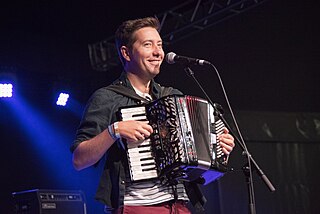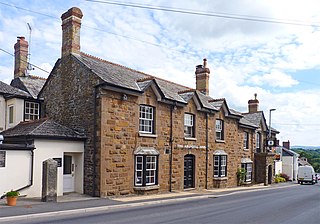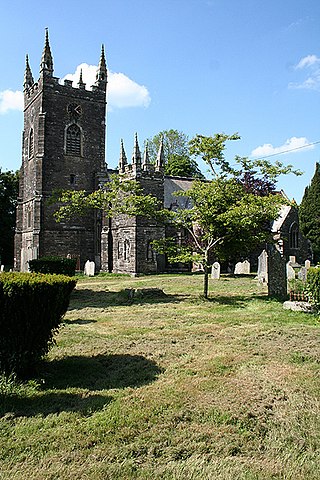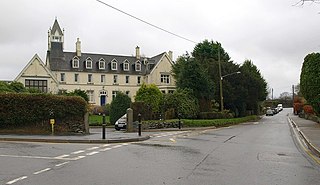
The Prayer Book Rebellion or Western Rising was a popular revolt in Cornwall and Devon in 1549. In that year, the first Book of Common Prayer, presenting the theology of the English Reformation, was introduced. The change was widely unpopular, particularly in areas where firm Catholic religious loyalty still existed, such as Lancashire. Along with poor economic conditions, the enforcement of the English language led to an explosion of anger in Cornwall and Devon, initiating an uprising. In response, Edward Seymour, 1st Duke of Somerset sent John Russell to suppress the revolt, with the rebels being defeated and its leaders executed two months after the beginning of hostilities.

Charles Stanley Causley CBE FRSL was a Cornish poet, school teacher and writer. His work is often noted for its simplicity and directness as well as its associations with folklore, legends and magic, especially when linked to his native Cornwall.

Callington is a civil parish and town in east Cornwall, England, United Kingdom about 7 miles (11 km) north of Saltash and 9 miles (14 km) south of Launceston.
Rugby union in Cornwall is Cornwall's most popular spectator sport with a large following. The followers of the national side are dubbed Trelawny's Army. In 1991 and 1999 Cornwall won the County Championship final played at Twickenham Stadium, beating Yorkshire and Gloucestershire respectively to win the Cup. They had another strong spell in the 2010s, reaching seven of the eight finals contested between 2013 and 2022, winning four of them.
Alfred Kenneth Hamilton Jenkin was a Cornish bard and historian with a particular interest in Cornish mining, publishing The Cornish Miner, now a classic, in 1927.

Boconnoc is a civil parish in Cornwall, England, United Kingdom, approximately four miles (6 km) east of the town of Lostwithiel. According to the 2011 census the parish had a population of 96.
Launceston, also known at some periods as Dunheved, was a parliamentary constituency in Cornwall which returned two Members of Parliament to the British House of Commons from 1295 until 1832, and one member from 1832 until 1918. It was a parliamentary borough until 1885, and a county constituency thereafter.

Jim Causley is an English folk singer, songwriter, and musician from Devon who specializes in the traditional songs and music of the West Country. Journalist Colin Irwin has called him "the finest singer of his generation".

Lifton is a village and civil parish in Devon, South West England near the confluence of the rivers Wolf and Lyd, 1¼ miles south of the A30 trunk road and very near the border between Devon and Cornwall. The village is part of the electoral ward of Thrushel. The population of the surrounding Thrushel ward at the 2011 census was 1680.

Werrington is a civil parish and former manor now in Cornwall, England, United Kingdom. Prior to boundary changes it straddled the Tamar and lay within the county of Devon. The portion on the west side was transferred to Cornwall by the abolition of Broadwoodwidger Rural District by the Local Government Commission for England in 1966. It is situated 1 mile (1.6 km) to the west of the Tamar, the traditional boundary between Devon and Cornwall, and 1 mile (1.6 km) north of Launceston.

Launceston Rugby Club is a Cornish rugby club which play at Polson Bridge, Launceston, Cornwall. They are currently in Regional 1 South West, at the fifth tier of the English rugby union system following their promotion from Tribute South West 1 West via a play-off in 2019. At present the club fields two senior men's teams, colts (under-18), mini/junior sides, as well as several girls teams.

Lawhitton is a village in the civil parish of Lawhitton Rural, in east Cornwall, England, United Kingdom. The village is situated two miles (3 km) southwest of Launceston and half-a-mile west of Cornwall's border with Devon at the River Tamar.

South Petherwin is a village and civil parish in east Cornwall, England, United Kingdom. It is in the Registration District of Launceston. The civil parish is bounded to the north by the Launceston parishes of St Thomas and St Mary Magdalene, to the east by Lawhitton and Lezant parishes and to the west by Trewen parish. The population of the parish in the 2001 census was 932. The district falls in the Altarnun electoral ward but the population of the civil parish at the 2011 Census was almost unchanged at 931.

Morval is a rural civil parish, hamlet and historic manor in southeast Cornwall, England, United Kingdom. The hamlet is approximately two miles (3 km) north of Looe and five miles (8 km) south of Liskeard.

Launceston College is a coeducational secondary school and sixth form with academy status, located in Launceston, Cornwall, England.

Launceston is a town, ancient borough, and civil parish in Cornwall, England, United Kingdom. It is 1 mile (1.6 km) west of the middle stage of the River Tamar, which constitutes almost the entire border between Cornwall and Devon. The landscape of the town is generally steep particularly at a sharp south-western knoll topped by Launceston Castle. These gradients fall down to the River Kensey and smaller tributaries.
Charles Harward was an Anglican priest, born in Hayne House Plymtree, Devon.

Penmere Manor Hotel near Falmouth, Cornwall, is a house of historical significance and is Grade II listed on the English Heritage Register. It was built in about 1825 by a wealthy sea captain and was the home of numerous notable people over the next 150 years. It is now a hotel which provides accommodation and restaurant facilities and has a leisure club.

Rose in Vale Country House Hotel, in Mithian, Cornwall, England, UK, is a building of historical significance and is Grade II* listed on the English Heritage Register. It was originally a 17th-century Cornish longhouse that consisted of two cottages. In 1761, Mr Thomas Nankivell bought the property and added the Georgian frontage. It was the home of several prominent people over the next two hundred years. Today, it is a hotel that provides accommodation and restaurant facilities and caters to special events, particularly weddings.

Shire Hall is a former judicial facility at Mount Folly Square in Bodmin, Cornwall. It was the main courthouse in Cornwall from 1838 to 1988. It is a Grade II* listed building.





















